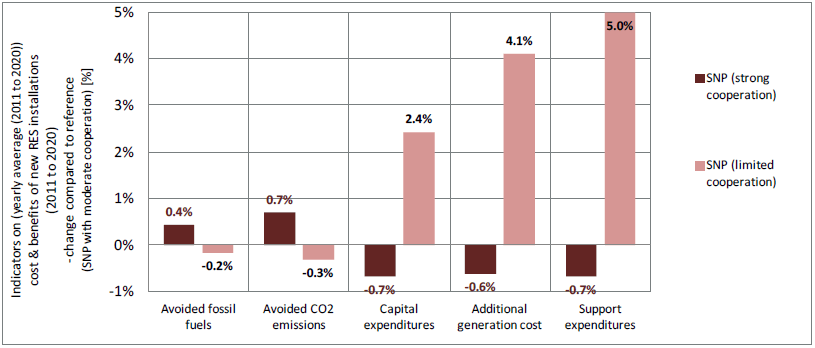
Subsequently we aim to shed light on the need for and impact of cooperation between Member States, discussing selected outcomes of the model-based prospective RES policy assessment conducted within RE-Shaping.
Current RES deployment as well as the potentials and the corresponding cost of future RES options differ among Member States. In the previously discussed default scenario of “strengthened national policies” an efficient and effective resource exploitation is assessed assuming moderate level of cooperation between Member States. Thus, the reference case of “moderate (RES) cooperation” can be classified as compromise between:
Next the outcomes of a sensitivity analysis performed on the use of cooperation mechanisms are discussed briefly. Following the classification of boundaries related to their use two sensitivity variants of “strengthened national RES policies” have been researched, assuming either a “limited” or a “strong cooperation”. (7)

Figure 2-6: (Virtual) exchange of RES volumes between Member States in 2020 according to selected variants of “strengthened national RES policies”, assuming limited, moderate (default) or strong cooperation between Member States, expressed in relative terms (i.e. share in gross final energy demand) (top) and absolute terms (TWh) (bottom).
As a starting point, Figure 2-6 (above) provides a graphical illustration of (virtual) exchange of RES volumes needed in 2020 for RES target fulfilment according to distinct scenarios on the extent of use of RES cooperation (i.e. from limited to strong), showing the remaining resulting import and export volumes in relative terms (i.e. as share of gross final energy demand (top)) and in absolute terms (i.e. TWh (bottom)).
Notably, also with tailored national support schemes in place not all countries have sufficient realisable (8) potentials to fulfil their 2020 RES obligation purely with domestic action. As applicable from the graph, within all cases Belgium, France, Italy, Luxembourg, the Netherlands and Slovenia have to rely on RES imports by 2020. Summing up the required imports of all related countries, a gap of 76 TWh occurs in the case of “limited cooperation” which needs to be covered via imports from other Member States which exceed their national obligations. This accounts for 2.6% of the total of required RES deployment by 2020 (2911 TWh) and emphasises the need for intensifying cooperation between Member States also if “national thinking” (of using domestic resources to gain related benefits etc.) maintains its dominance. According to the default variant of “moderate cooperation” the exchange of RES volumes is expected to increase to 108 TWh (or 3.7% of total RES volumes) by 2020, and the highest extent of using cooperation mechanisms is achieved under the variant named “strong cooperation”. This would increase the (net) exchange of RES between countries to 138 TWh (or 4.7% of total RES). Moreover, “strong cooperation” should allow for more efficient and effective target achievement than purely domestic action.

Figure 2-7: Indicators on yearly average (2011 to 2020) cost and benefits of new RES installations (2011 to 2020) for selected variants of “strengthened national RES policies”, assuming limited, moderate (default) or strong cooperation between Member States, expressed as deviation to the (default) case of moderate RES cooperation.
A closer look on Figure 2-7 indicates that cooperation appears beneficial at the aggregated (EU) level: Strong (instead of moderate) cooperation would increase benefits slightly, for example fossil fuel avoidance by 0.4%, and lead to a more pronounced decrease of related cost and expenditures. Thus, additional generation cost for new RES installations would decrease by 0.6% and capital as well as support expenditures by 0.7%. In contrast to above, pure “national thinking” as conditioned in the case of “limited cooperation” would decrease benefits insignificantly (-0.2 to -0.3%), but cause a strong increase of additional generation cost (4.1% compared to reference) as well as capital (2.4%) and support expenditures (5%).
| <<Back | >>Back to Introduction<< | Next>> |
(6) Within the corresponding model-based assessment the assumption is taken that in the case of “limited cooperation / National perspective” the use of cooperation mechanisms as agreed in the RES Directive is reduced to necessary minimum: For the exceptional case that a Member State would not possess sufficient RES potentials, cooperation mechanisms would serve as a complementary option. Additionally, if a Member State possesses barely sufficient RES potentials, but their exploitation would cause significantly higher support expenditures compared to the EU average, cooperation would serve as complementary tool to assure target achievement.
(7) In the “strong cooperation / European perspective” case economic restrictions are applied to limit differences in applied financial RES support among Member States to an adequately low level – i.e. differences in country-specific support per MWh RES are limited to a maximum of 8 €/MWhRES.while in the “limited cooperation / National perspective” variant this feasible bandwidth is set to 20 €/MWhRES. Consequently, if support in a country with low RES potentials and / or an ambitious RES target exceeds the upper boundary, the remaining gap to its RES target would be covered in line with the flexibility regime as defined in the RES Directive through (virtual) imports from other countries.
(8) In the case of “limited cooperation” weak economic restrictions are conditioned to the exploitation of RES potentials, meaning that support levels for certain RES technologies may differ significantly between Member States (i.e. by up to 20 € per MWhRES).